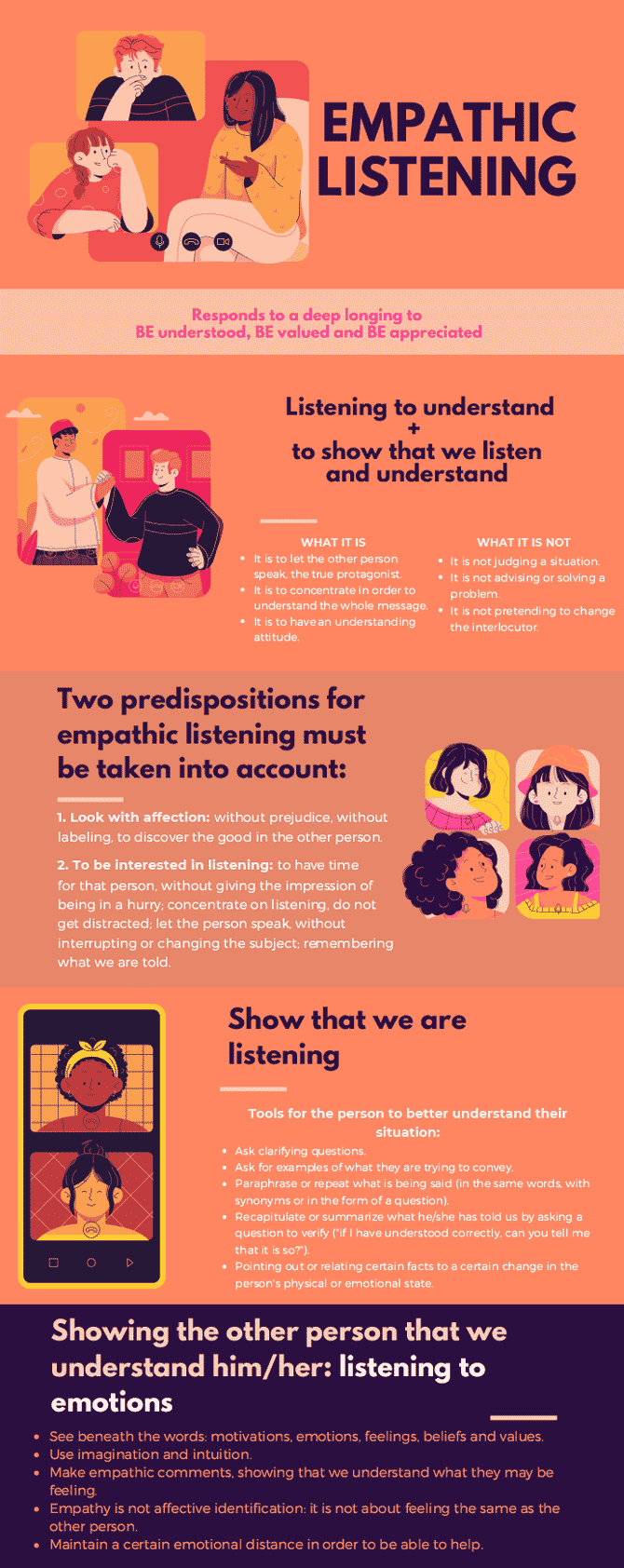Infographic: Empathic listening
Tips for listening and understanding
Everyone has a deep longing to be understood, valued and appreciated. When dealing with another person, what we say to them may not interest them at all. However, it is unlikely that they are indifferent to feeling understood.
- Original article in Spanish
- Download the infographic and text in PDF
- Download the infographic in high quality SVG
We are not just talking about “understanding another person” but about “feeling understood”. This is what empathic listening is all about: listening to understand and showing that we listen and understand. Listening well is a gift, as seen in Momo, written by Michael Ende.
Friendship and spiritual accompaniment require that necessary dimension of charity which is understanding. Through this, we gradually discover that the understanding we can give each other is only a slight reflection of the full paternal and maternal understanding of God towards his children, mankind.
In fact, this desire to be loved and understood that we carry imprinted in our hearts is surely a sign of our desire for God. We thus walk towards “a new heaven and a new earth”, where the Lord will wipe away every tear, and there will be no crying, no shouting, no pain (cf. Revelation 21:1-4).
Tips for listening with a truly empathetic and understanding attitude
This kind of attitude soothes without hurting:
1. Be aware of what empathic listening is not
In empathic listening, it is the other person’s intervention that is fundamental, not ours. Therefore, empathic listening is not judging a situation, nor is it advising or solving a problem, nor is it pretending to change the interlocutor, nor is it telling one’s own story. In empathic listening the protagonist is the other person.
It may happen that while we are listening, we are thinking about what we are going to say next. Although both tasks are not incompatible, when we listen, our main task is to concentrate on understanding the totality of the message we are receiving with an understanding attitude.
It may happen that while we are listening, we are thinking about what we are going to say next. Although both tasks are not incompatible, when we listen, our main task is to concentrate on understanding the totality of the message we are receiving with an understanding attitude.
2. Take care of two predispositions for empathic listening:
- a) To look at the other person with affection is to look at them without prejudice, trying to “put the brakes” on that natural tendency we have to prejudge and label others because of who they are or what they have done. Even if the convictions of the person we are listening to are far removed from our own, we can try to appreciate that each person is unique and unrepeatable, discover the good in them and renounce the desire to make them in our image.
- b) Being interested in listening to the other person will be reflected in the fact that we have time for that person, without giving a feeling of hurry to finish; that we are concentrated in listening to him/her, without getting distracted; that we let him/her talk, without interrupting or changing the subject; that we remember what he/she has told us, etc. In short, we listen with respect and interest because we are interested in the person we are talking to. From a supernatural point of view, we could say that we are interested in that person because we look at him or her with the eyes of Christ, that is, with a gaze of deep affection and affection.
3. Show the other person that we are listening
Empathic listening is not a technique but a vital attitude. We listen to the one we love. We may not feel anything for the person we are listening to, we may even feel a certain rejection, but we can understand that he or she is a creature loved by God and this can provide us with the necessary motivation to listen to him or her.
Starting from this premise, there are tools that can help us to show the other person that we are listening: ask clarifying questions, ask for examples of what he is trying to transmit, paraphrase or repeat what he is saying (with the same words, with synonyms or in the form of a question), recapitulate or summarize what he has told us, asking a question to verify (“if I have understood correctly, you tell me that…, is that so? “), pointing out or relating certain facts to a certain change in the person’s physical or emotional state, etc.
By putting into practice in a timely and natural way some of these interventions we can better understand what is happening to the other person and help him/her to better understand his/her situation or problem.
4. Show the other person that you understand them
This last phase involves listening to the other person’s emotions. Often, underneath the words there are motivations, emotions, feelings, beliefs or values that sometimes the person is not able to express accurately. To empathize it is necessary to make proper use of imagination and intuition to find out what underlies the words we are hearing.
Then, if appropriate, we can make empathic comments to show the other person that we understand what they may be feeling. Finally, it should be emphasized that empathy is not affective identification, that is, it is not about feeling the same as the other person.
In this sense, and especially in areas such as spiritual accompaniment or psychotherapy, it is necessary for the person listening to maintain a certain emotional distance to avoid generating affective dependencies that, in the long run, could be detrimental to both people.
José María Martínez-Ortega














